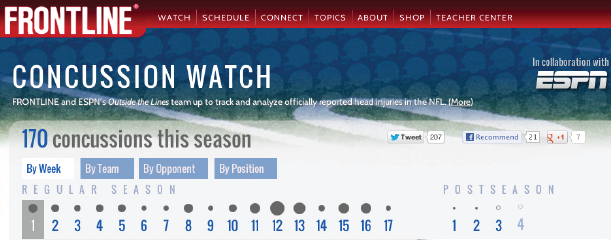 |
| The Concussion Watch website created by “Frontline” exemplifies the investigative series’ entrance into the digital realm, allowing for fan engagement early and often during the documentary making process. |
On Feb. 3, all eyes will be focused on New Orleans, where we’ll find out who will be Super Bowl champs: the San Francisco 49ers or the Baltimore Ravens. Prediction? PR News doesn’t want to affect the point spread, so we’ll pass. However, we do predict that approximately one-third of the audience will actually watch the game, one-third will tune in to see Kate Upton’s Mercedes-Benz commercial and another third will be watching Beyoncé to see if she’s lip-synching during the halftime show.
Meanwhile, as the NFL prepares for its penultimate event of the season, a media partnership between two major broadcast outlets—ESPN and PBS’s “Frontline”—continues, and it’s a collaboration that could have a major effect on the NFL and the sports world in general in the fall of 2013.
On Nov. 16, 2012, ESPN’s investigative sports news program “Outside the Lines” and PBS’s “Frontline” kicked off a joint initiative that comprehensively explores the ongoing story of concussions in the NFL. On that day, a segment on former Pittsburgh Steeler center Mike Webster, who was the first NFL player officially diagnosed with chronic traumatic encephalopathy (CTE), or “football brain disease,” was aired.
Today nearly 4,000 former players are suing the NFL over the link between football and long-term brain damage. Just this week the family of former San Diego Charger Junior Seau, who in 2012 took his own life and was recently found to have CTE, joined that group of plaintiffs.
The issue of concussions is one that has dogged the NFL for years and won’t go away. Now, this formidable collaboration between ESPN and PBS could plunge the NFL into an even greater PR crisis.
Culminating with a full-length documentary that will launch the fall 2013 season of “Frontline,” selected information gathered by ESPN reporters Steve Fainaru and Mark Fainaru-Wada, and “Frontline” producers Tom Jennings and Sabrina Shankman, will be revealed through a variety of platforms in the months leading up to the premiere.
It’s a strategy that’s born from the growing use of digital platforms at “Frontline,” says Raney Aronson, the show’s deputy executive producer. “We’re not just a documentary series anymore,” Aronson says. “We can actually publish along the way.” ESPN and “Frontline” are looking for opportunities to break news on the concussion problem leading up to the finished documentary. “It’s as if we have a rolling story for about a year and a half,” she says.
It’s not the first time “Frontline” has collaborated with other media outlets. In recent years, some of the series’ more high-profile investigations have also been produced as collaborations, including Post Mortem (with NPR, ProPublica, the Investigative Reporting Program at the UC Berkeley Graduate School of Journalism and California Watch) and Law & Disorder (with ProPublica and the New Orleans Times-Picayune).
According to Aronson, such partnerships represent a strategic change at “Frontline,” which turned 30 this year. “It used to be we’d hold back for the film,” she says. Now that content is rolled out on a regular basis leading up the film, Frontline’s web traffic is up and audience interest builds to a crescendo, she adds.
The ESPN/PBS collaboration is “the perfect PR storm,” says Ned Barnett, CEO of Barnett Marketing Communications and a member of the PR News Advisory Board. Indeed, you’ve got two major broadcast outlets in ESPN and PBS with a bevy of resources at their disposal, a team of talented reporters and producers, and the promise of what should be a highly controversial full-length documentary and book (to be published by Crown Archetype, a division of Random House).
EDITORIAL LEADS
Such an initiative doesn’t start with communications, says David Scott, director of communications for ESPN’s news content and lead author of the network’s external blog, Front Row.
“These collaborations work best when it’s not just the PR staffs in synch—but the editorial staffs as well,” Scott says. “It’s a matter of keeping everyone in the editorial loop. That makes what we do all the more easy.”
Yet it’s communications that’s steering the content leading up to the launch of the documentary this fall. The Webster story was featured on both the ESPN and “Frontline” websites, and a podcast featuring brothers Fainaru and Fainaru-Wada was offered on Front Row. This week the brothers authored a piece revealing that CTE has been found in living patients. As the investiation continues, the public can expect more concussion content to emerge.
DIGITAL ENGAGEMENT
To keep the project interactive with the fans, Concussion Watch (www.pbs.org/wgbh/pages/frontline/concussion-watch/), a website tracking each concussion officially identified by the NFL in the 2012-2013 season, debuted in December. Fans were invited to report questionable hits and possible concussions by filling out a form available on the website. Their observations are followed up on by “Frontline” staffers.
The site fills a void in the concussion conversation, Aronson says. “The NFL doesn’t have a public database that’s updated as concussions happen,” she says. “We’re trying to give an over-arching view and have football fans participate in the process.”
And speaking of the NFL, Aronson says the “Frontline” team is in touch with the league; discussions with the league are ongoing, as the reporting progresses. Barnett stresses that it’s safe to say the NFL would be anxious about the ESPN/PBS initiative.
But ESPN and “Frontline” are forging ahead, riding a huge wave of collaboration that is a perfect PR storm.
CONTACT:
Raney Aronson, @raneyaronson; David Scott, @ESPNprDScott; Ned Barnett, @nedbarnett.
